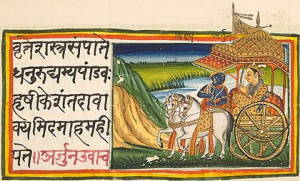Language/Sanskrit/Vocabulary/Express-Surprise
Hi Sanskrit learners! 😊
In this lesson, we will be learning how to express surprise in Sanskrit. It is always interesting to learn new expressions to communicate better with native speakers. By the end of this lesson, you will have a better understanding of Sanskrit and will be able to surprise your Sanskrit speaking friends! 😮
With the completion of this lesson, consider investigating these related pages: How to Say Hello and Greetings & Animals.
Vocabulary[edit | edit source]
Let's start with some basic vocabulary words that you can use to express surprise:
| Sanskrit | Pronunciation | English |
|---|---|---|
| दृष्टं | dṛṣṭaṃ | seen |
| अस्ति | asti | is |
| मम | mama | my |
| च | ca | and |
| अहः | ahaḥ | day |
| किम् | kim | what |
Expressions[edit | edit source]
Now that we have some vocabulary, let's learn some basic expressions to surprise someone:
1. दृष्टं अस्ति! (dṛṣṭaṃ asti!)[edit | edit source]
This expression translates to "I have seen it!", which can be used to express surprise or disbelief. You can also use this expression when you are surprised by something that you did not expect to see.
- Person 1: क्या तुमने नया फोन खरीदा? (kyā tumne nayā phōn kharīdā?) (Did you buy a new phone?)
- Person 2: दृष्टं अस्ति! (dṛṣṭaṃ asti!) (I have seen it!)
2. किमस्य आह्लादोऽयमहम् (kimasya āhlādō'yamaham)[edit | edit source]
This expression translates to "Whose joy is this?" and is used to express surprise when you find something unexpected. You can use it to show your amazement when you see something that is not ordinary.
- Person 1: देखो, उसके घर में एक हाथी हैं! (dēkhō, usakē ghar mēṁ ēka hāthī haiṁ!) (Look, there is an elephant in his house!)
- Person 2: किमस्य आह्लादोऽयमहम् (kimasya āhlādō'yamaham) (Whose joy is this?)
3. वयं दृष्टं किंचिदस्तु (vayaṁ dṛṣṭaṁ kiñcidastu)[edit | edit source]
This expression translates to "We have seen something!" and can be used to express surprise when you have come across something unexpected.
- Person 1: तुमने कमाल कर दिया! (tumne kamāl kar diyā!) (You have done a great job!)
- Person 2: वयं दृष्टं किंचिदस्तु (vayaṁ dṛṣṭaṁ kiñcidastu) (We have seen something!)
4. अस्तु सत्यं त्वं प्रणम्य (astu satyaṁ tvaṁ praṇamya)[edit | edit source]
This expression translates to "It is true, I bow to you" and can be used to express surprise when someone has done something extraordinary.
- Person 1: मैंने सोचा था कि तुम मेरी मदद नहीं करोगे, लेकिन तुमने मुझे बचाया! (maimne sōchā thā ki tum merī madad nahī̃ karōgē, lēkin tumnē mujhē bachāyā!) (I thought you wouldn't help me, but you saved me!)
- Person 2: अस्तु सत्यं त्वं प्रणम्य (astu satyaṁ tvaṁ praṇamya) (It is true, I bow to you)
Dialogue[edit | edit source]
Here is a dialogue that you can use to practice the expressions that we learned above:
- Person 1: उस लड़के के पास एक बाघ होता है। (us laṛkē kē pās ēka bāgha hōtā hai.) (That boy has a tiger.)
- Person 2: दृष्टं अस्ति! (dṛṣṭaṃ asti!) (I have seen it!)
- Person 1: वहाँ एक सांप भी है! (vahā̃ ēka sāmp bhī hai!) (There is also a snake there!)
- Person 2: किमस्य आह्लादोऽयमहम् (kimasya āhlādō'yamaham) (Whose joy is this?)
- Person 1: तुमने उसको कैसे बचाया? (tumne usakō kaisē bachāyā?) (How did you save him?)
- Person 2: वयं दृष्टं किंचिदस्तु (vayaṁ dṛṣṭaṁ kiñcidastu) (We have seen something!)
- Person 1: तुमने मुझे बचाया! (tumne mujhē bachāyā!) (You saved me!)
- Person 2: अस्तु सत्यं त्वं प्रणम्य (astu satyaṁ tvaṁ praṇamya) (It is true, I bow to you)
Culture[edit | edit source]
In Sanskrit culture, there are many festivals and events where it is customary to share expressions of surprise and amazement. One such event is the festival of Holi, where people throw colored powder and water on each other. During this festival, people often exclaim "वाह! क्या रंग है!" (vāh! kyā raṅg hai!) which translates to "Wow! What a color!"
Conclusion[edit | edit source]
Congratulations! You have learned how to express surprise in Sanskrit. Don't forget to practice these expressions with your friends and family. To improve your Sanskrit vocabulary, you can also use the Polyglot Club website. Find native speakers and ask them any questions!
➡ If you have any questions, please ask them in the comments section below.
➡ Feel free to edit this wiki page if you think it can be improved. 😎
Sources[edit | edit source]
- Sanskrit Vocabulary - Express Surprise
- 60 years later, Sanskrit dictionary stuck in first letter - Indian Express
- A Big Sanskrit English Dictionary (With Transliteration) | Exotic India ...
Other Lessons[edit | edit source]

